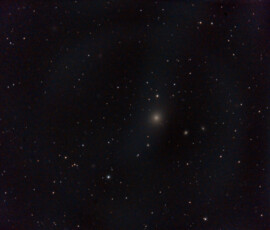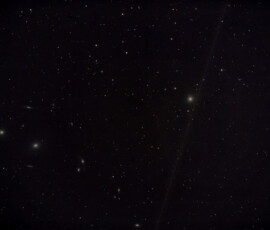Messier 87 (also known as Virgo A or NGC 4486, ) is a supergiant elliptical galaxy in the constellation Virgo. One of the most massive galaxies in the local universe, it is notable for its large population of globular clusters—M87 contains about 12,000 compared to the 150-200 orbiting the Milky Way—and its jet of energetic plasma that originates at the core and extends outward at least 1,500 parsecs (4,900 light-years), travelling at relativistic speed. (Visible toward 5pm from the galaxy.) It is one of the brightest radio sources in the sky. The jet is probably powered by a prograde accretion disk around a spinning supermassive black hole.
The distance estimate is 16.4 ± 0.5 megaparsecs (53.5 ± 1.63 million light-years).

M87
Messier 87 (also known as Virgo A or NGC 4486, ) is a supergiant elliptical galaxy in the constellation Virgo. One of the most massive galaxies in the local universe, it is notable for its large population of globular clusters—M87 contains about 12,000 compared to the 150-200 orbiting the Milky Way—and its jet of energetic plasma that originates at the core and extends outward at least 1,500 parsecs (4,900 light-years), travelling at relativistic speed. (Visible toward 5pm from the galaxy.) It is one of the brightest radio sources in the sky. The jet is probably powered by a prograde accretion disk around a spinning supermassive black hole.
The distance estimate is 16.4 ± 0.5 megaparsecs (53.5 ± 1.63 million light-years).
Photographed with CPC 9,25″ reflector telescope and Nikon D800 DSLR camera in Åva, March 2016. Exposure was 15 * 150 s with aotoguiding,

M87
Messier 87 (right) is a supergiant elliptical galaxy in the constellation Virgo. One of the most massive galaxies in the local universe, it is notable for its large population of globular clusters—M87 contains about 12,000 compared to the 150–200 orbiting the Milky Way—and its jet of energetic plasma that originates at the core and extends outward at least 1,500 parsecs (4,900 light-years), travelling at relativistic speed. (Visible to the left in my picture.)
The distance estimate is 16.4 ± 0.5 megaparsecs (53.5 ± 1.63 million light-years).
Photographed with APO107 refractor telescope and Nikon D800 DSLR camera from my garden in Stuvsta, April 2018. Exposure was 9 * 2 min at ISO 800.